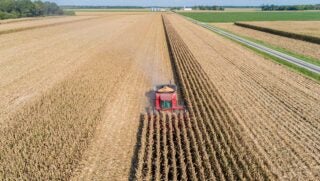If you do nothing else after reading this article, please remember to wash your produce, whether it comes from a conventional farm, an organic farm, or your own garden.
Because here’s the secret that organizations such as the Environmental Working Group and Moms Across America like to suppress: Just about all farmers use pesticides — it doesn’t matter whether they’re operating a conventional or organic farm. That pesticide can be in the form of an herbicide, fungicide, insecticide, or something else, but it’s about as common in apple orchards as it is in corn fields. Crop protection products are what help make agriculture scalable by a dwindling workforce, and help maintain the consistent quality of our food.
Activist groups routinely publish lists and warnings about glyphosate on your food — if you’re not familiar with that chemical, maybe it’ll register better to you if we’d say “Monsanto’s glyphosate,” because that’s pretty much the only way the alarmist natural-food activists ever write it. (Insider’s tip: Glyphosate has been off patent since 2000, so it’s made by multiple companies now.)
What gets overlooked by these groups are the reports from the USDA itself that show that even organic foods have pesticide residues on them — some are synthetic pesticides and some, like Spinosad, are ones approved for organic uses. Feel comfortable, though, because that same USDA data showed safe levels for consuming both commercial and organic products.
Notably, when we say that many organic products have residue on them, the focus shouldn’t necessarily be directed at American farmers. A massive percentage of organic food consumed in America is imported, with China and Turkey being prime sources. And, it’s not uncommon for mainstream media such as The Washington Post or NPR to note that the farmers in these countries bend the rules significantly (actually, let’s call a spade a spade — they flat out break the rules) to get that organic label on there.
Are you really more confident about the “organic” beans you got from Turkey than you are the conventional ones grown here in the States?
It’s really no surprise that the U.S. is looking overseas to fill its organic needs. The section of the USDA that oversees organic produce is the Agricultural Marketing Service. Not the Food Safety and Inspection Service or the agency’s environmental wing — it’s the marketing side. That alone makes the National Organic Program sound more gimmicky than substantive.
Here’s the bottom line: The reason why so many commercial farmers get frustrated amid the hype about organic — and the massively rising amount of government investment in it — is threefold:
- Yields are less (typically far less) with organic products, so more land is needed to maintain the quantities. More land for farming means more habitat destruction and diminished biodiversity. By comparison, “high-yield” farming has been shown to do more to spare habitat.
- Pesticides used in organic production, while toxic, are often broad spectrum and can be less efficient than synthetics — thus often requiring more applications. That means more chance for runoff and more passes across the field with the tractor and sprayer, raising the carbon footprint of the farm. Modern synthetic insecticides are more targeted to individual pest species, and are used with increased scrutiny by farmers.
- Speaking of the carbon footprint, tillage is a much more widely used tool in organic production to suppress weeds, and exposing the soil in that way destroys organic carbon and releases carbon dioxide into the atmosphere. Conventional farmers, with the help of the Natural Resources Conservation Service, have made huge strides toward going no-till or using conservation till methods.
This doesn’t even dive into more farm-specific nuances of organic agriculture such as the use of manure, which can be laden with pathogens if not properly composed or if applied too close to the crop harvest date. Nor is this article intended to call out the marketing tactics of the organic industry bigwigs, whose financial stake in the industry drives their stances.
This is about the farmers. Better yet, American farmers. (The folks in the nation to the north are cool, too.) Though food safety is often portrayed in the media as a chemical issue, it’s more than that — it’s one of biological and physical hazards, too. (That’s why washing even garden produce is important.)
The activist tactic of testing 10 products for glyphosate — particularly with confidential methods and non-peer-reviewed research — shouldn’t change the world. But in some ways, it does change things, thanks to perceptions. People can find themselves listening to a tiny segment of activism that is then amplified through social channels. They forget about the farmers affected by the negativity, the ones who believe in what they are doing and why, from their yields to their farmland protection to their carbon footprint, they feel they are doing what’s best for American families.
The United States is a big country with big demands. Just about all of our food is sprayed and processed in some way, whether through packaging or blending or something else. Any contamination is more likely to show up in the those later channels than it is in the fields. Still, it’ll never hurt to eat food from the produce section of your grocery store or from your farmer’s market.
Just be sure to wash it first.
Ryan Tipps is the managing editor for AGDAILY. He has covered farming since 2011, and his writing has been honored by state- and national-level agricultural organizations.



